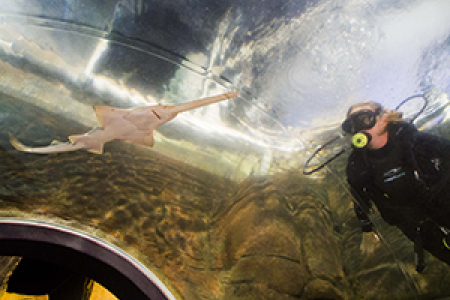Researcher investigates sawfish survival
A researcher is exploring how removing sawfish from their natural habitats to display in public aquariums affects the critically endangered species’ population numbers.
Charles Darwin University’s Research Institute for the Environment and Livelihoods PhD candidate Kate Buckley is researching the conservation benefits of displaying Largetooth Sawfish and Speartooth Sharks in public aquariums.
Ms Buckley is also investigating whether sawfish can integrate into the wild after being released from aquariums once they outgrow their tanks, at about two metres long.
She said sawfish were appealing for aquariums to display because they adapted well to tanks and were a unique, eye-catching species.
“It is really important to find out whether people’s knowledge about sawfish, their attitudes and their behaviours change after seeing these animals on display,” she said.
“If people see the sawfish on display and then pick rubbish and fishing nets off the beach and act responsibly with their own rubbish, all these things can have direct impacts on wildlife.”
Ms Buckley said little research had been conducted about how well sawfish reintegrated into the wild after being held in captivity for extended periods.
As part of her study, she released five Largetooth Sawfish back into the river to monitor their survival rates after they had been captured in the Northern Territory’s Adelaide River and held in captivity for six months.
She said these sawfish showed similar movements to other wild sawfish in the river, which indicated that their wild instincts may not have been lost after being held in captivity.
“It is a really good sign,” Ms Buckley said. “The wild and the released sawfish are both doing relatively similar things in the water.”
She said the research could be applied to other threatened species displayed in aquariums.
